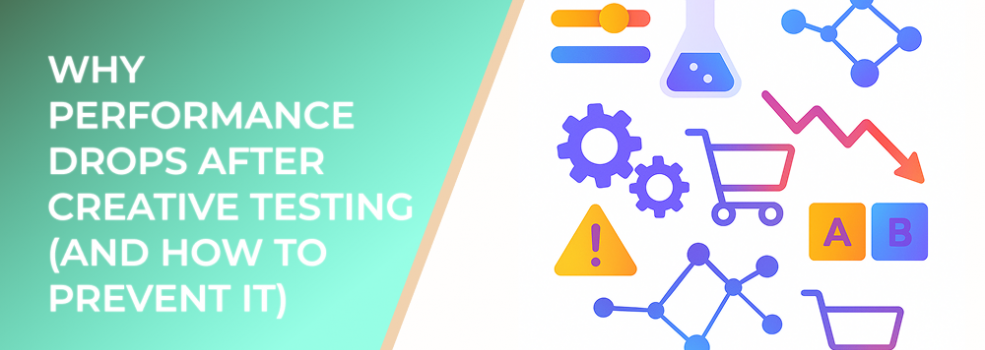Creative is the biggest controllable driver of Meta ad performance, yet many advertisers see CPA/ROAS swing the moment they start testing. That’s not a signal to stop testing—it’s a sign that the test design, pacing, or measurement is introducing noise. Let’s unpack why dips happen and how to prevent them.
Useful statistics at a glance
-
Learning sensitivity: Adding or removing multiple ads in one ad set can extend or reset learning, temporarily increasing CPA by 12–35% for 48–96 hours while delivery re‑stabilizes.
-
Spend concentration: In most tests, 70–90% of spend flows to the top 1–2 ads within the first 24–48 hours, starving other variants and skewing results.
-
Fatigue half‑life: For always‑on accounts, top creatives typically show measurable fatigue (CTR down, CPC up) within 7–14 days at steady spend; heavy scaling can cut that to 3–7 days.
-
Attribution variance: Changing attribution windows during or after a test can swing reported ROAS by 15–30% on the same cohort, masking true creative impact.
-
Overlap tax: Running near‑identical tests across ad sets targeting similar broad audiences can raise CPMs by 5–18% due to internal auction competition.
Ranges reflect common patterns observed in performance accounts across e‑commerce and lead gen; your outcomes will vary by vertical, AOV, funnel length, and audience size.
Why performance drops right after a test
1) You changed too many variables at once
New ads, new audiences, budget moves, and bidding tweaks all at the same time create attribution noise and learning resets.
Fix: Lock the environment. During a creative test cycle, change one thing: the creative. Freeze budgets and keep the same optimization event and attribution window.
2) The algorithm crowned a short‑term winner
Meta will quickly favor the first ad that gets cheap signals. Sometimes that’s a click‑bait headline that doesn’t convert or retain.
Fix: Judge on down‑funnel proxies (Initiate Checkout, Qualified Lead, Add Payment Info) or value‑based events—not just CTR/CPC.
3) Budget fragmentation and overlap
Multiple small ad sets siphon data and compete in the same auctions, inflating CPMs and slowing learning.
Fix: Consolidate into fewer, healthier ad sets. Use exclusions and one clean test lane per audience cluster.
4) Frequency and fatigue after the test
When a test “winner” absorbs the budget, frequency spikes and performance slips within days.
Fix: Rotate concepts on a cadence; cap total active ads; refresh variants before frequency >3 in 7 days.
5) Reporting pitfalls
Switching attribution windows mid‑test, mixing modeled and non‑modeled results, or comparing different lookback windows makes losers look like winners.
Fix: Pre‑define the window (e.g., 7‑day click) and keep it constant for the entire test and the post‑test readout.
A low‑volatility creative testing framework
Design tests that protect your baseline while still learning fast.
1) Structure
-
Maintain two lanes: Control (always‑on) and Test (creative concepts).
-
In the Test lane, use the same optimization event, attribution window, and broad audience as Control.
2) Pacing
-
Launch 2–3 concepts at a time; keep ≤6 total live ads per ad set.
-
Allow 72 hours minimum or 50+ conversion‑adjacent events per ad before pruning.
-
Scale or cut in ≤20% budget steps and avoid mid‑day edits.
3) Guardrails
-
Set a stop‑loss CPA/CPL that auto‑pauses clear underperformers after sufficient volume.
-
Cap frequency to protect audience health; refresh variants weekly at scale.
-
Use placement‑aware versions when quality depends on attention (e.g., Feeds vs Reels).
4) Measurement
-
Pre‑register success metrics: primary (CPA/ROAS), secondary (IC, ATC, Qualified Lead), and creative diagnostics (hook rate, 3‑sec view, scroll‑stop rate).
-
Annotate any changes (budget, event, window) and don’t compare across different windows.
Creative metrics that predict winners
-
Hook rate (3‑sec views ÷ impressions): early attention quality.
-
Thumb‑stop ratio (plays to 50% ÷ plays): mid‑video retention for Reels/Stories.
-
Outbound CTR: traffic efficiency to landing pages.
-
Qualified rate: % of sessions that reach a quality gate (e.g., Quiz Complete, MQL form with score ≥X).
-
Cost per qualified event: best single metric when full conversions are sparse.
Sample 2‑week testing calendar
Mon: Launch 3 new concepts (same offer, 2 hooks + 1 format shift).
Tue: No edits. Track diagnostics only.
Wed: Prune any concept >40% worse on cost per qualified event with adequate volume.
Thu: Replace pruned ad with a variant (new opening 2 seconds).
Fri: If a winner emerges, move it to Control at +15% budget.
Mon (Week 2): Introduce 2 fresh variants; retire fatigued ad if freq >3/7d or CTR down 20% from baseline.
Wed–Fri: Hold settings; read results at constant attribution.
Troubleshooting: performance dipped after the test—now what?
-
Stabilize signals: revert to pre‑test attribution and optimization event.
-
Reduce variables: pause edits for 72 hours; hold budgets steady.
-
Concentrate spend: merge duplicative ad sets; keep one control broad and one test lane.
-
Refresh inputs: introduce 1–2 new concepts that answer the top objection surfaced in comments/UGC.
-
Re‑qualify leads: tighten event quality (e.g.,
Lead_Qualified) and upload offline conversions where possible.
Creative ideas that test well without destabilizing delivery
-
Narrative swaps: Problem → Solution vs Solution → Proof openings.
-
Format flips: 1:1 feed cut vs 9:16 native reels with on‑screen captions.
-
Angle shifts: Price anchor vs Social proof vs Demo close‑up.
-
Offer clarity: Add a time‑bound bonus; test the title card only.
Executive summary
-
Expect a short‑term dip after creative launches; it’s often a learning effect, not a strategy failure.
-
Protect the baseline with controlled lanes, slow budget moves, and constant attribution.
-
Judge winners by down‑funnel quality, not only front‑end clicks.
-
Keep a steady creative cadence so you’re never scaling a single ad into fatigue.

